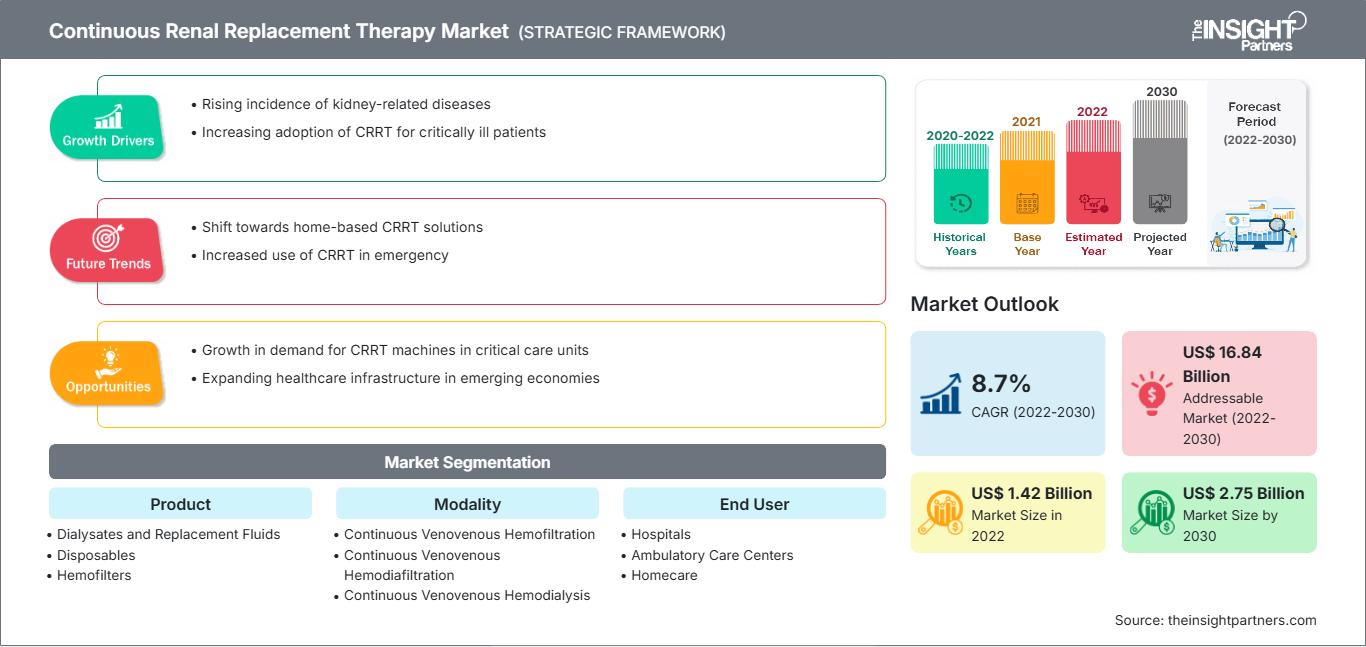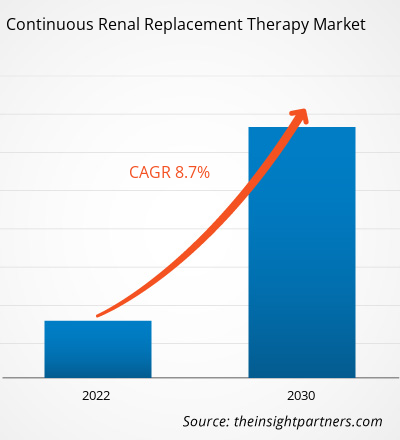[Rapporto di ricerca] Si prevede che il mercato della terapia sostitutiva renale continua crescerà da 1,42 miliardi di dollari nel 2022 a 2,75 miliardi di dollari entro il 2030. Si stima che il mercato registrerà un CAGR dell'8,7% dal 2022 al 2030.
Approfondimenti di mercato e punto di vista degli analisti:
Questo rapporto include le prospettive di crescita dovute alle attuali tendenze del mercato della terapia sostitutiva renale continua e al loro impatto prevedibile durante il periodo di previsione.
La terapia sostitutiva renale continua (CRRT) è un intervento salvavita per i pazienti affetti da grave danno renale acuto (IRA), sovraccarico di liquidi e uremia con anomalie metaboliche potenzialmente fatali. Fattori come l'aumento della domanda di dispositivi CRRT pediatrici e l'elevata prevalenza di malattie croniche che portano a malattie renali spingono la crescita del mercato della terapia sostitutiva renale continua. Tuttavia, una probabilità significativa di un evento avverso renale maggiore (MAKE) limita la crescita del mercato.
Fattori trainanti del mercato:
Elevata incidenza di malattie croniche che portano a malattie renali
1 persona su 10 a livello globale è affetta da malattia renale cronica (MRC), una condizione comune e potenzialmente letale. Dal 2015 al 2019, il diabete e l'ipertensione sono state le due principali cause di insufficienza renale nel 75% dei casi totali di insufficienza renale. Secondo le stime pubblicate dalla National Kidney Foundation nel 2020, negli Stati Uniti circa il 30% della popolazione diabetica di età superiore ai 20 anni è a rischio di sviluppare MRC nel corso della vita. Inoltre, questa malattia ha causato più decessi del cancro alla prostata o del cancro al seno nel 2020 ed è un disturbo sanitario d'urgenza poco riconosciuto. 1 adulto americano su 3 (ovvero circa 80 milioni di persone) è a rischio di malattia renale cronica (MRC), che è ora identificata come un chiaro fattore di rischio per l'insufficienza renale acuta (AKI). La riduzione della velocità di filtrazione glomerulare (GFR) e l'aumento della proteinuria sono fortemente associati all'AKI. Secondo il National Institute of Health, l'incidenza dell'AKI è in aumento nei paesi sviluppati. Si prevede che la sua prevalenza tra i pazienti ricoverati in ospedale raggiungerà il 15%, ed è più elevata nei pazienti critici, ovvero il 60%. L'incidenza dell'AKI tra i pazienti ricoverati in tutto il mondo varia dallo 0,7% al 31%; i pazienti in terapia intensiva (UTI) presentano un'incidenza superiore al 50%. Un intervallo compreso tra il 3% e il 13% dei pazienti con AKI necessita di terapia renale sostitutiva (RT) e si stima che il 40% di questi pazienti necessiti di CRRT per più di 90 giorni. Pertanto, l'elevata prevalenza di malattie croniche che portano a patologie renali stimola la crescita del mercato della terapia sostitutiva renale continua.
I principali effetti collaterali associati alla CRRT includono ipotensione, tachicardia e altre aritmie, che possono influire negativamente sulle condizioni del paziente o impedirne il recupero. Inoltre, il circuito CRRT potrebbe facilitare una più rapida eliminazione di micronutrienti, oligoelementi e/o farmaci terapeutici, che possono portare a concentrazioni basse o irregolari nel sangue e nei tessuti, causando effetti avversi e/o perdita dell'effetto terapeutico. Pertanto, gli effetti avversi limitano il mercato della terapia sostitutiva renale continua.
Personalizza questo rapporto in base alle tue esigenze
Potrai personalizzare gratuitamente qualsiasi rapporto, comprese parti di questo rapporto, o analisi a livello di paese, pacchetto dati Excel, oltre a usufruire di grandi offerte e sconti per start-up e università
Mercato della terapia sostitutiva renale continua: Approfondimenti strategici

-
Ottieni le principali tendenze chiave del mercato di questo rapporto.Questo campione GRATUITO includerà l'analisi dei dati, che vanno dalle tendenze di mercato alle stime e alle previsioni.
Segmentazione e ambito del rapporto:
L'analisi del mercato della terapia sostitutiva renale continua è stata condotta considerando i seguenti segmenti: prodotto, modalità e utente finale.
Analisi segmentale:
Il mercato della terapia sostitutiva renale continua, per prodotto, è segmentato in dializzati e fluidi di sostituzione, materiali monouso, set e tubi per linee ematiche, sistemi CRRT ed emofiltri. Il segmento dei sistemi CRRT ha rappresentato la quota maggiore del mercato nel 2022. Si prevede che il segmento degli emofiltri registrerà il CAGR più elevato del mercato tra il 2022 e il 2030.
Per modalità, il mercato della terapia sostitutiva renale continua è segmentato in emofiltrazione veno-venosa continua (CVVH), emodiafiltrazione veno-venosa continua (CVVHDF), emodialisi veno-venosa continua (CVVHD) e ultrafiltrazione continua lenta (SCUF). Il segmento dell'emofiltrazione veno-venosa continua (CVVH) ha detenuto la quota maggiore del mercato nel 2022. Si prevede che il mercato dell'emodiafiltrazione veno-venosa continua (CVVHDF) registrerà il CAGR più elevato tra il 2022 e il 2030.
Per utente finale, il mercato della terapia sostitutiva renale continua è segmentato in ospedali, centri di assistenza ambulatoriale, assistenza domiciliare e altri. Nel 2022, il segmento ospedaliero ha dominato la quota di mercato della terapia sostitutiva renale continua. Tuttavia, si prevede che il segmento del monitoraggio domiciliare registrerà il CAGR più elevato tra il 2022 e il 2030.
Analisi regionale:
L'ambito del rapporto di mercato sulla terapia sostitutiva renale continua comprende Nord America (Stati Uniti, Canada e Messico), Europa (Spagna, Regno Unito, Germania, Francia, Italia e resto d'Europa), Asia Pacifico (Corea del Sud, Cina, India, Giappone, Australia e resto dell'Asia Pacifico), Medio Oriente e Africa (Sudafrica, Arabia Saudita, Emirati Arabi Uniti e resto del Medio Oriente e Africa) e Sud e Centro America (Brasile, Argentina e resto dell'America meridionale e centrale).
In termini di fatturato, nel 2022, il Nord America ha dominato la quota di mercato della terapia sostitutiva renale continua. Si prevede che il mercato nell'area Asia-Pacifico registrerà il CAGR più elevato tra il 2022 e il 2030. Il mercato della terapia sostitutiva renale continua nella regione Asia-Pacifico è in crescita grazie al miglioramento delle infrastrutture sanitarie e all'adozione di tecnologie CRRT innovative, entrambi associati all'aumento della spesa sanitaria. Inoltre, le iniziative strategiche degli operatori del mercato volte ad espandere la propria presenza nella regione Asia-Pacifico, come le collaborazioni con gli operatori sanitari locali, favoriscono la crescita del mercato nella regione.
Approfondimenti regionali sul mercato della terapia sostitutiva renale continua
Le tendenze regionali e i fattori che influenzano il mercato della terapia sostitutiva renale continua durante il periodo di previsione sono stati ampiamente spiegati dagli analisti di The Insight Partners. Questa sezione illustra anche i segmenti e la geografia del mercato della terapia sostitutiva renale continua in Nord America, Europa, Asia-Pacifico, Medio Oriente e Africa, America meridionale e centrale.
Ambito del rapporto di mercato sulla terapia sostitutiva renale continua
| Attributo del rapporto | Dettagli |
|---|---|
| Dimensioni del mercato in 2022 | US$ 1.42 Billion |
| Dimensioni del mercato per 2030 | US$ 2.75 Billion |
| CAGR globale (2022 - 2030) | 8.7% |
| Dati storici | 2020-2022 |
| Periodo di previsione | 2022-2030 |
| Segmenti coperti |
By Prodotto
|
| Regioni e paesi coperti |
Nord America
|
| Leader di mercato e profili aziendali chiave |
|
Densità degli operatori del mercato della terapia sostitutiva renale continua: comprendere il suo impatto sulle dinamiche aziendali
Il mercato della terapia sostitutiva renale continua (CRT) è in rapida crescita, trainato dalla crescente domanda degli utenti finali, dovuta a fattori quali l'evoluzione delle preferenze dei consumatori, i progressi tecnologici e una maggiore consapevolezza dei benefici del prodotto. Con l'aumento della domanda, le aziende stanno ampliando la propria offerta, innovando per soddisfare le esigenze dei consumatori e sfruttando le tendenze emergenti, alimentando ulteriormente la crescita del mercato.

- Ottieni il Mercato della terapia sostitutiva renale continua Panoramica dei principali attori chiave
Panorama competitivo e aziende chiave:
Il rapporto di mercato sulla terapia sostitutiva renale continua si concentra su importanti attori del mercato come Baxter International Inc, Asahi Kasei, Fresenius Medical Care, Medica SpA, Medtronic Plc, B. Braun, Nikkiso Co Ltd, Toray Medical Co Ltd, Infomed SA e Quanta Dialysis Technologies Inc. Le previsioni di mercato sulla terapia sostitutiva renale continua possono aiutare gli stakeholder a pianificare le loro strategie di crescita. Queste aziende si concentrano sul lancio di nuove tecnologie, sull'aggiornamento dei prodotti esistenti e sull'espansione delle loro attività per soddisfare la crescente domanda dei consumatori in tutto il mondo.
- Nell'aprile 2022, la Food and Drug Administration (FDA) statunitense ha rilasciato l'autorizzazione 510(k) per il set ST di Baxter International Inc. per il suo utilizzo nella terapia sostitutiva renale continua (CRRT). Il set ST è un circuito extracorporeo (esterno al corpo) pre-connesso e monouso che consente la purificazione del sangue attraverso una membrana semipermeabile da utilizzare con le unità di controllo (monitor) PrisMax o Prismaflex.
- A marzo 2022, Nipro Medical Corporation (Nipro), produttore e fornitore leader di prodotti renali, vascolari e medico-chirurgici, ha annunciato il lancio commerciale del sistema di emodialisi SURDIAL DX negli Stati Uniti. SURDIAL DX è un sistema di emodialisi all'avanguardia progettato per offrire un'esperienza di trattamento dialitico ottimale a pazienti e medici. Prodotto in Giappone, il prodotto si basa su oltre 35 anni di esperienza nell'innovazione di dispositivi renali presso la società madre di Nipro, Nipro Corporation.
- Analisi storica (2 anni), anno base, previsione (7 anni) con CAGR
- Analisi PEST e SWOT
- Valore/volume delle dimensioni del mercato - Globale, Regionale, Nazionale
- Industria e panorama competitivo
- Set di dati Excel
Report recenti
Testimonianze
Motivo dell'acquisto
- Processo decisionale informato
- Comprensione delle dinamiche di mercato
- Analisi competitiva
- Analisi dei clienti
- Previsioni di mercato
- Mitigazione del rischio
- Pianificazione strategica
- Giustificazione degli investimenti
- Identificazione dei mercati emergenti
- Miglioramento delle strategie di marketing
- Aumento dell'efficienza operativa
- Allineamento alle tendenze normative






















 Ottieni un campione gratuito per - Mercato della terapia sostitutiva renale continua
Ottieni un campione gratuito per - Mercato della terapia sostitutiva renale continua